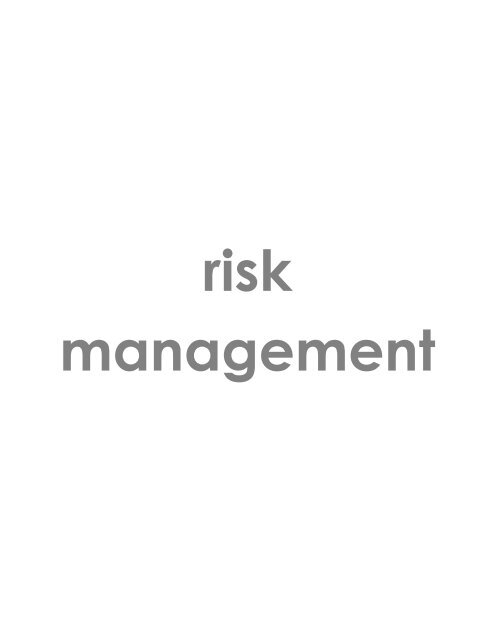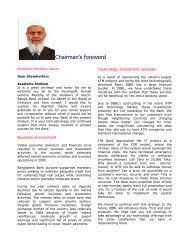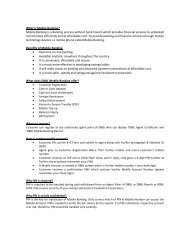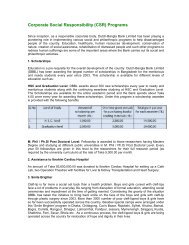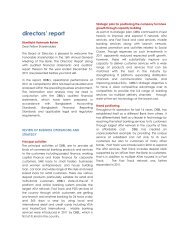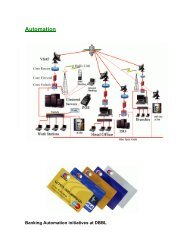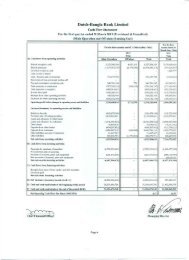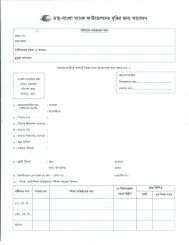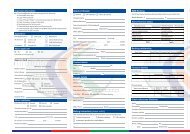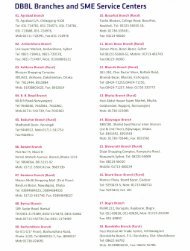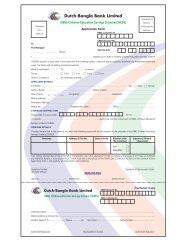Risk management - Dutch-Bangla Bank Limited
Risk management - Dutch-Bangla Bank Limited
Risk management - Dutch-Bangla Bank Limited
You also want an ePaper? Increase the reach of your titles
YUMPU automatically turns print PDFs into web optimized ePapers that Google loves.
isk<br />
<strong>management</strong>
isk <strong>management</strong><br />
In this section a summarized position of various<br />
risks facing DBBL while conducting its business<br />
and operations and steps taken by the <strong>Bank</strong><br />
to effectively manage and mitigate such risks<br />
are discussed.<br />
RISK MANAGEMENT FRAMEWORK<br />
<strong>Risk</strong> is defined by DBBL as risk of potential losses<br />
or foregone profits that can be triggered by<br />
internal and external factors. Therefore, the<br />
objectives of risk <strong>management</strong> are<br />
identification of potential risks in our operations<br />
and transactions, in our assets, liabilities,<br />
income, cost and off-balance sheet exposures<br />
and independent measurement and<br />
assessment of such risks and taking timely and<br />
adequate measures to manage and mitigate<br />
such risks within a risk-return framework.<br />
In DBBL, only calculated risks are taken while<br />
conducting banking business to strike a<br />
balance between risk and return. <strong>Risk</strong> is clearly<br />
identified, mitigated or minimized and if<br />
possible eliminated to protect capital and to<br />
maximize value for shareholders. It is also<br />
ensured that on-balance sheet and offbalance<br />
sheet, risks taken by the <strong>Bank</strong> are<br />
consistent with risk appetite and short term as<br />
well as long term strategic objectives of the<br />
<strong>Bank</strong>.<br />
A wide range of tools and techniques are<br />
used to address & mitigate all kinds of<br />
inherent and potential risks in banking<br />
operations. The <strong>Bank</strong> attaches highest priority<br />
to establish, maintain and upgrade risk<br />
<strong>management</strong> infrastructure, systems and<br />
procedures. In this regard, sufficient resources<br />
are allocated to improve skills and expertise of<br />
relevant banking professionals to manage the<br />
risk effectively. The policies and procedures<br />
are approved by the Board and assessed on a<br />
regular basis to bring these to the level of<br />
satisfaction required to manage & mitigate<br />
the risks adequately and consistently.<br />
Ultimate responsibility for effective risk<br />
<strong>management</strong> lies with the Board of Directors<br />
of DBBL. The Board itself and through<br />
delegated authority to various committees of<br />
the Board, like Audit Committee and<br />
Executive Committee, sets principles and<br />
limits, review and monitor various risks to<br />
assess adequacy of system and to ensure that<br />
the <strong>Bank</strong> is operating within approved systems<br />
& procedures. Through delegated authority,<br />
<strong>management</strong> committees, like ALCO and<br />
Credit Committee, also oversee and ensure<br />
that sufficient risk <strong>management</strong> systems are in<br />
place and these are consistently applied to<br />
protect the interest of the <strong>Bank</strong>.<br />
RISK MANAGEMENT PROCEDURE<br />
Approved predetermined policies and<br />
guidelines<br />
To ensure that risks are properly addressed<br />
and protected for sustainable development of<br />
the <strong>Bank</strong>, there are approved policies and<br />
procedures covering all the risk areas i.e.<br />
credit risks, operational risks, market risks and<br />
residual risks. These are formulated taking into<br />
account <strong>Bangla</strong>desh <strong>Bank</strong>’s Guidelines on<br />
managing Core <strong>Risk</strong>s on Credit <strong>Risk</strong><br />
Management, Internal Control & Compliance<br />
<strong>Risk</strong> Management, Asset and Liability <strong>Risk</strong><br />
Management, Foreign Exchange <strong>Risk</strong><br />
Management, Information Technology <strong>Risk</strong><br />
Management and Money Laundering <strong>Risk</strong><br />
Management as well as the business<br />
environment in which the <strong>Bank</strong> operates,<br />
specific needs for particular type of operations<br />
or transactions and international best<br />
practice. These policies are regularly reviewed
and updated to keep pace with the changing<br />
operating environment, technology and<br />
regulatory requirement. Meticulous<br />
compliance with the established procedures<br />
are ensured to satisfy that the <strong>Bank</strong> is<br />
operating within approved procedures and<br />
limits and that risks are within tolerable limits to<br />
effectively ensure long term solvency and<br />
sustainable growth of the <strong>Bank</strong>.<br />
<strong>Risk</strong> <strong>management</strong> infrastructure<br />
<strong>Risk</strong> <strong>management</strong> procedures are approved,<br />
monitored, and mitigated at various stages of<br />
the <strong>Bank</strong> with a combination of Board, its<br />
committees, <strong>management</strong> committees,<br />
<strong>management</strong> units and Internal Control &<br />
Compliance Division as detailed below:<br />
Board of Directors<br />
Board oversees and approves all major risk<br />
<strong>management</strong> policies and parameters taking<br />
into account market condition, regulatory<br />
requirement and lessons learned in the past.<br />
While setting policies and parameters for<br />
credit, operational and market risks, a<br />
balance is maintained for ensuring smooth<br />
banking operations while protecting against<br />
down side risk from potential loss or foregone<br />
income and to protect interest of shareholders<br />
and depositors.<br />
Executive Committee (EC) of the Board<br />
Executive Committee is responsible to oversee<br />
that the <strong>management</strong> and its committees are<br />
operating within approved limits and<br />
authorities and that all major risks are<br />
managed & mitigated effectively, and<br />
potential and actual losses arising from risks<br />
are within the acceptable limits. EC also<br />
approves all credit proposals, administrative<br />
proposals and major purchases as<br />
recommended by the Credit Committee,<br />
Management Committee and Purchase<br />
Committee respectively<br />
Audit Committee of the Board<br />
Audit Committee independently monitors all<br />
activities of banking operations involving<br />
credit risks, operational risks and market risks<br />
through Internal Control & Compliance<br />
Division of the <strong>Bank</strong>. <strong>Risk</strong> based audit plan for<br />
IC & CD is approved by the Committee and its<br />
implementation is monitored on a regular basis<br />
to ensure that all risk factors are adequately<br />
addressed and any deviation is quickly<br />
corrected to ensure sustainable operation of<br />
banking activities.<br />
Management Committees<br />
Committees like Credit Committee, Asset &<br />
Liability Management Committee, Purchase<br />
Committee, Management Committee<br />
comprising of senior executives and heads of<br />
divisions ensure compliance with all relevant<br />
risk <strong>management</strong> policies and strategies. On<br />
top of these, now there is a high level <strong>Risk</strong><br />
Management Unit (RMU) overseeing and<br />
mitigating all the major existing and potential<br />
risks facing the <strong>Bank</strong> in carrying out its business<br />
and operational activities.<br />
Management units<br />
Management units like Credit <strong>Risk</strong><br />
Management Division, Treasury Division, Credit<br />
Administration Division, Credit Monitoring &<br />
Recovery Division etc. ensure and monitor risk<br />
<strong>management</strong> system and compliance with all<br />
approved limits and procedure at operational<br />
level on a daily basis.<br />
Internal Control & Compliance Division<br />
directly reporting to Audit Committee of<br />
the Board<br />
Internal Control & Compliance Division on a<br />
regular basis independently verifies<br />
compliance with all approved risk<br />
<strong>management</strong> and internal control policies.<br />
Deviations are identified, reported and<br />
corrected to mitigate risk on a continuous<br />
basis and to ensure that the <strong>Bank</strong> is operating<br />
in compliance with all approved and
established policies. Internal Control &<br />
Compliance Division directly reports to the<br />
Audit Committee of the Board.<br />
Credit <strong>Risk</strong><br />
Credit risk is the most significant and inherent<br />
risk in banking business. Every loan exposure or<br />
transaction with counterparty involves the<br />
<strong>Bank</strong> to some degree of credit risks. Credit <strong>Risk</strong><br />
Management is at the heart of the overall risk<br />
<strong>management</strong> system of the <strong>Bank</strong>. It is<br />
designed and continuously updated to<br />
identify, measure, manage and mitigate<br />
credit risk to maintain and improve quality of<br />
loan portfolio and reduce actual loan losses<br />
and to ensure that approved processes are<br />
followed and appropriate due diligence are<br />
made in approving new credit facilities and<br />
renewals.<br />
Early warning system<br />
Operation and performance of loans are<br />
regularly monitored to trigger early warning<br />
system to address the loans whose<br />
performance show any deteriorating trend<br />
enabling the <strong>Bank</strong> to grow its credit portfolio in<br />
a sustainable way to ensure higher quality<br />
and lower risk with the ultimate objective to<br />
protect the interest of depositors and<br />
shareholders.<br />
Credit policy approved by the Board<br />
The Board approves the major policy<br />
guidelines, growth strategy, exposure limits for<br />
particular sector, product, individual company<br />
and group, keeping in view regulatory<br />
compliance, risk <strong>management</strong> strategy and<br />
industry best practice.<br />
Credit approval is delegated properly<br />
Credit approval authorities are carefully<br />
delegated to the Executive Committee of the<br />
Board and appropriate level of <strong>management</strong><br />
to strike a balance between adequate<br />
control and flexibility in credit operations to<br />
ensure full transparency and accountability at<br />
all levels.<br />
Independent Credit <strong>Risk</strong> Management<br />
Division<br />
There is an independent risk <strong>management</strong><br />
division to assess credit risks and suggest<br />
mitigations before recommendation of every<br />
credit proposal.<br />
Separate Credit Administration Division for<br />
documentation<br />
A separate credit administration division<br />
confirms that perfected security documents<br />
are in place before disbursement. DBBL is<br />
continuing a unique process of rechecking<br />
security documentation by a second legal<br />
adviser other than the lawyer who vetted it<br />
originally.<br />
Independent Credit Monitoring &<br />
Recovery Division<br />
An independent and fully dedicated credit<br />
monitoring and recovery division monitors the<br />
performance and recovery of loans, identify<br />
early signs of delinquencies in portfolio and<br />
take corrective measures including legal<br />
actions to mitigate risks, improve loan quality<br />
and to ensure recovery of loans on time. This<br />
division also monitors risk status of loan<br />
portfolio and ensures adequate loan loss<br />
provision.<br />
Adequate provision & suspension of<br />
interest<br />
Interest accrued on classified loan is<br />
suspended and adequate provision is<br />
maintained there against as per <strong>Bangla</strong>desh<br />
<strong>Bank</strong>’s Guidelines.<br />
Credit operations are subject to<br />
independent Internal Audit<br />
Internal Control & Compliance Division<br />
independently verifies and ensures, at least<br />
once in a year, compliance with approved<br />
lending guidelines, <strong>Bangla</strong>desh <strong>Bank</strong>
guidelines, operational procedures, adequacy<br />
of internal control and documentation.<br />
Reporting to Board / Executive Committee<br />
Overall quality, performance, recovery status,<br />
risks status, adequacy of provision against loan<br />
portfolio are regularly reported to the Board of<br />
Directors/Executive Committee of the Board<br />
for information and guidance.<br />
Market risk<br />
Market risk is the risk of losses in on and offbalance<br />
sheet positions arising from<br />
movements in market price such as changes<br />
in interest rate and price of equity, foreign<br />
exchange and commodity.<br />
Liquidity, interest rate and foreign<br />
exchange risks<br />
The Treasury Division manages the liquidity,<br />
interest rate and foreign exchange risks with<br />
oversight from Asset-Liability Management<br />
Committee (ALCO) comprising senior<br />
executives of the <strong>Bank</strong>. ALCO is chaired by the<br />
Managing Director. The Committee meets at<br />
least once in a month. The Board approves all<br />
risk <strong>management</strong> policies, sets limits and<br />
reviews compliance on a regular basis. The<br />
overall objective is to provide cost effective<br />
funding to finance the asset growth and trade<br />
related transactions, optimize the funding<br />
cost, increase spread with the lowest possible<br />
liquidity, maturity, foreign exchange and<br />
interest rate risks.<br />
Liquidity risks<br />
Liquidity risk is the risk that the <strong>Bank</strong> may not<br />
meet its financial obligation as they become<br />
due. Liquidity risks also include its inability to<br />
liquidate any asset at reasonable price in a<br />
timely manner. It is the policy of the <strong>Bank</strong> to<br />
maintain adequate liquidity at all times in both<br />
local and foreign currencies. Liquidity risks are<br />
managed on a short, medium and long-term<br />
basis. There are approved limits for credit /<br />
deposit ratio, liquid assets to total assets ratio,<br />
maturity mismatch, commitments for both onbalance<br />
sheet and off-balance sheet items<br />
and borrowing from money market to ensure<br />
that loans & investments are funded by stable<br />
sources, maturity mismatches are within limits<br />
and that cash inflow from maturities of assets,<br />
customer deposits in a given period exceeds<br />
cash outflow by a comfortable margin even<br />
under a stressed liquidity scenario.<br />
Foreign Exchange <strong>Risk</strong><br />
Foreign exchange risk is potential loss arising<br />
from changes in foreign currency exchange<br />
rate in either direction. Assets and liabilities<br />
denominated in foreign currencies have<br />
foreign exchange risks.<br />
The <strong>Bank</strong> operates its foreign exchange and<br />
money market activities under a centralized<br />
and single functional area. DBBL’s dealing<br />
room is equipped with advanced technology<br />
and experienced personnel. <strong>Bank</strong>'s Exchange<br />
Rate Committee meets on a daily basis to<br />
review the prevailing market condition,<br />
exchange rate, exposure and transactions to<br />
mitigate foreign exchange risk.<br />
Operational <strong>Risk</strong><br />
Operational risk is the risk of loss resulting from<br />
inadequacy or failure of internal processes,<br />
systems and people or from external events.<br />
Internal Control & Compliance <strong>Risk</strong><br />
The Board of Directors approved updated<br />
policy guidelines on Internal Control &<br />
Compliance <strong>Risk</strong> (ICC) <strong>management</strong> thereby<br />
restructuring the organizational chart of the<br />
<strong>Bank</strong> in accordance with the instructions of<br />
<strong>Bangla</strong>desh <strong>Bank</strong> for managing core risks. In<br />
line with the aforesaid policy guidelines, <strong>Bank</strong>’s<br />
own working manual on ICC has been<br />
approved by the Board of Directors and the<br />
manual is now in operation.<br />
Internal Control & Compliance Division of the<br />
<strong>Bank</strong> under direct supervision of Audit<br />
Committee of the Board has been
implementing detail guidelines on ICC risk<br />
<strong>management</strong> to assess and mitigate risks and<br />
as part of it the IC&CD has been divided into<br />
three (3) independent units; namely :-<br />
a) Audit & inspection unit<br />
b) Monitoring unit<br />
c) Compliance unit<br />
The units have been functioning<br />
independently & separately with direct<br />
reporting lines to the Head of IC&CD.<br />
In addition, Departmental Control Function<br />
Check List has been introduced in the<br />
branches & divisions at head office under<br />
direct supervision of Monitoring Unit of IC&CD<br />
which ensures compliance with regulatory<br />
rules and regulations as well as general<br />
banking norms and procedures.<br />
Documentation Check List has been brought<br />
in practice under supervision of dedicated<br />
unit. Exceptions are addressed, monitored and<br />
corrected on a regular basis.<br />
Policy guidelines on <strong>Risk</strong> Based Internal Audit<br />
(RBIA) system have been formulated and the<br />
branches have already been brought under<br />
RBIA networks. As per RBIA, marks have been<br />
allocated for rating of the branches in terms of<br />
business risk & control risks. The branches<br />
scoring more are being subjected to audit<br />
with more frequency.<br />
Vigilance Cell<br />
A Vigilance Cell was established in 2009 with<br />
dedicated team to reinforce operational risk<br />
<strong>management</strong> of the <strong>Bank</strong>. The Cell deals with<br />
urgent operational issues to ensure adequate<br />
internal control in business operations of the<br />
<strong>Bank</strong>.<br />
The Complaint Cell of the <strong>Bank</strong> has been<br />
placed under Vigilance Cell to ensure speedy<br />
disposal of the complaints of our valued<br />
customers. Besides, Zonal Compliant cells set<br />
up at all divisional head quarters’ cities, are<br />
also being looked into by them so as to ensure<br />
quick disposal of the problems faced by<br />
customers at farthest corners of the country.<br />
The Vigilance Cell keeps close liaison with<br />
Customer’s Interest Protection Center in<br />
<strong>Bangla</strong>desh <strong>Bank</strong> in this respect.<br />
All these activities of the Internal Control &<br />
Compliance Division and Vigilance Cell are<br />
devoted to address and mitigate operational<br />
risks of the <strong>Bank</strong> in a more effective way to<br />
ensure efficiency & effectiveness of<br />
performance, ensure reliability and<br />
completeness of financial and <strong>management</strong><br />
information and to ensure compliance with<br />
legal and regulatory requirements.<br />
Money Laundering <strong>Risk</strong><br />
In order to prevent money laundering, Money<br />
Laundering Prevention Act, 2002 was enacted<br />
in our country to give tight rein on money<br />
laundering process. <strong>Bangla</strong>desh <strong>Bank</strong><br />
undertook a project in the year 2003 to review<br />
the global best practices in the risk areas in<br />
view of globalization of business and identified<br />
5 (five) core risks for implementation by the<br />
banks which included, among others, Money<br />
Laundering <strong>Risk</strong>. Money Laundering Prevention<br />
Act, 2009 was enacted in 2009 to update the<br />
previous Act.<br />
In line with the money laundering law and<br />
relevant guideline of <strong>Bangla</strong>desh <strong>Bank</strong> on<br />
Money Laundering risk, our <strong>Bank</strong> has already<br />
formulated guidelines on policies &<br />
procedures on prevention of Money<br />
Laundering. The prime objective of the<br />
guidelines is to combat Money Laundering in<br />
an effective way.<br />
As per the guidelines of <strong>Bangla</strong>desh <strong>Bank</strong>,<br />
Uniform Account Opening Form for all banks<br />
has been introduced for obtaining particulars<br />
of Personal Identity of customer and
Transaction Profile. The <strong>Bank</strong> has also<br />
undertaken enhanced due diligence in case<br />
of opening of accounts of Politically Exposed<br />
Persons( PEP) as per directive of <strong>Bangla</strong>desh<br />
<strong>Bank</strong> which is in line with recommendation of<br />
Financial Action Task Force of United Nations.<br />
Anti Money Laundering units have been set up<br />
in all the branches under a central unit at<br />
Head Office. Basic training has been imparted<br />
to most of the officers of the <strong>Bank</strong> on<br />
compliance with rules & regulations of Money<br />
Laundering Prevention Act so as to prevent<br />
opening of suspicious accounts and identify<br />
suspicious transactions.<br />
In order to prevent terrorist financing through<br />
money laundering, Anti-Terrorism Act, 2009<br />
was promulgated in 2009. DBBL has taken<br />
necessary steps for compliance with the Act.<br />
Legal <strong>Risk</strong>s<br />
In DBBL, legal risks are covered by recognizing<br />
potential losses from litigation or possible<br />
litigation at an early stage and by formulating<br />
solutions for reducing, restricting and avoiding<br />
such risks and creating adequate provision<br />
thereagainst.<br />
OTHER RISKS<br />
Business <strong>Risk</strong><br />
Business risk covers the risk of losses arising from<br />
lower non-interest income and higher<br />
expenses from the budgeted amount. The<br />
business risk is resulted from the market<br />
condition, customer behavior or technological<br />
development that may change compared<br />
to the assumptions made at the time of<br />
planning.<br />
Business risk in DBBL is managed by setting<br />
clear targets for specific business units, in<br />
term of business volume, income, cost,<br />
cost/income ratio, quality of assets etc with<br />
an ongoing process of continuous<br />
improvement.<br />
Reputational <strong>Risk</strong><br />
Reputational risk is defined as the risk of losses,<br />
falling business volume or income as well as<br />
reduced value of the company arising from<br />
business events that may reduce the<br />
confidence of the customers & clients,<br />
shareholders, investors, counterparties,<br />
business partners, credit rating agencies,<br />
regulators and general public in DBBL.<br />
The branches and operational divisions are<br />
directly responsible for reputational risks arising<br />
from their business operations. Reputational<br />
risks may also arise from other risks. The<br />
<strong>management</strong> ensures that DBBL is aware of<br />
any changes in market perceptions as soon as<br />
possible. Accordingly, all business policies and<br />
transactions are subjected to careful<br />
consideration. DBBL takes necessary<br />
precautions to avoid business policies and<br />
transactions that may result in significant<br />
tax, legal or environmental risks. Reputational<br />
risk is also factored into major credit decisions<br />
that may lead to credit proposal being<br />
declined.<br />
Compliance <strong>Risk</strong><br />
The success of DBBL is largely dependent on<br />
the trust and confidence of our existing and<br />
potential customers, our shareholders, our<br />
staff, our regulators and the general public in<br />
our integrity and ethical standard. The<br />
confidence largely depends on meticulous<br />
compliance with applicable legal and<br />
regulatory requirements and internal policies<br />
of DBBL. The confidence also depends on<br />
conformity with generally accepted market<br />
norms and standards in our business<br />
operations. The Board of Directors is primarily<br />
responsible for compliance with all applicable<br />
norms and regulations. The Board discharges<br />
its responsibilities itself and through delegation<br />
of authorities to Executive Committee and<br />
Audit Committee of the Board. The objective is<br />
to identify any compliance risks at an early<br />
stage that may undermine the integrity and
the success of DBBL and to mitigate the risks in<br />
most appropriate way.<br />
Capital Plan and Management<br />
The <strong>Bank</strong> is committed to maintain a strong<br />
capital base to support business growth,<br />
comply with all regulatory requirements,<br />
obtain good credit rating and CAMELS rating<br />
and to have a cushion to absorb any<br />
unforeseen shock arising from credit,<br />
operational and market risks.<br />
The capital maintenance and dividend<br />
policies are pursued taking into consideration<br />
the following factors:<br />
Increased capital requirement for<br />
sustainable business growth.<br />
Keeping sufficient cushion to absorb<br />
unforeseen shock or stress<br />
Cost effective options for raising Tier 1<br />
and Tier 2 capital<br />
Improving credit rating and CAMELS<br />
rating of the <strong>Bank</strong><br />
Meeting Regulatory requirements<br />
Meeting covenants of lenders<br />
The Board is responsible to ensure capital<br />
<strong>management</strong> within a broad framework of risk<br />
<strong>management</strong>.<br />
The <strong>Bank</strong> has been pursuing a dividend policy<br />
that must ensure satisfactory return for<br />
shareholders as well as sustainable growth of<br />
the <strong>Bank</strong> with strong capital adequacy ratio to<br />
protect greater interest of depositors and<br />
shareholders.<br />
As per BRPD Circular Letter No. 11 dated<br />
August 14, 2008, the total capital of the <strong>Bank</strong><br />
should have been raised to Taka 4,000.00<br />
million latest by August 11, 2011 within which<br />
total paid up share capital would be minimum<br />
Taka 2,000.00 million. The <strong>Bank</strong> had already<br />
met the requirement much earlier before the<br />
deadline.<br />
The <strong>Bank</strong>’s, Tier 2 capital is strengthened by<br />
subordinated debt obtained from FMO,<br />
revaluation of fixed assets, revaluation of held<br />
to maturity securities and revaluation of held<br />
for trading securities. Other alternative options<br />
to raise Tier 2 capital would be explored as<br />
and when necessary.<br />
Implementation of BASEL II – Strengthening<br />
<strong>Risk</strong> Management System and Capital<br />
Base of the <strong>Bank</strong><br />
In order to have a sound and robust banking<br />
industry and to make the banks in <strong>Bangla</strong>desh<br />
more shock absorbent as well as to cope with<br />
international best practice for risk<br />
<strong>management</strong>, <strong>Bangla</strong>desh <strong>Bank</strong> introduced<br />
<strong>Risk</strong> Based Capital Adequacy (RBCA) for<br />
<strong>Bank</strong>s’ (Revised regulatory capital framework<br />
in line with Basel II) in our banking sector<br />
effective from January 1, 2010.<br />
As per guideline on ‘<strong>Risk</strong> Based Capital<br />
Adequacy for <strong>Bank</strong>s, calculation of RWA<br />
follows Standardised Approach for Credit <strong>Risk</strong>,<br />
Standardised Approach for Market <strong>Risk</strong> and<br />
Basic Indicator Approach for Operational <strong>Risk</strong>.<br />
Under the Standardised Approach of the <strong>Risk</strong><br />
Based Capital Adequacy framework (Basel II),<br />
<strong>Risk</strong> Weighted Asset (RWA) against credit risk is<br />
determined on the basis of credit rating<br />
assessed by External Credit Assessment<br />
Institutions (ECAIs).<br />
Under Basel II, regulatory Capital Adequacy<br />
Ratio (CAR) & Minimum Capital Requirement<br />
(MCR) was rescheduled in 2010 with the<br />
following timetable:<br />
o Upto June 2010 MCR is 8% of riskweighted<br />
assets.<br />
o Upto June 2011 MCR is 9% of risk<br />
weighted assets<br />
o From July 1, 2011, MCR is 10% of riskweighted<br />
assets.
DBBL has implemented Basel II in line with<br />
<strong>Bangla</strong>desh <strong>Bank</strong> guidelines<br />
In addition to credit risk, Basel-II also covers<br />
operational and market risk. Moreover, under<br />
Basel-II, in absence of credit rating of the<br />
borrowers, credit risk of the corporate loan is<br />
calculated at 125% of outstanding loan. As a<br />
result, risk weighted assets and capital<br />
requirement under Basel-II are substantially<br />
increased as compared to Basel-I particularly<br />
because credit rating of borrowers is a new<br />
phenomenon in <strong>Bangla</strong>desh. It has become a<br />
major challenge for our banking sector.<br />
However, better risk <strong>management</strong> system,<br />
capital increase and capacity building<br />
measures are underway to meet future<br />
requirement under the Basel II.<br />
DBBL maintained 11.2% CAR under Basel II as<br />
of 31 December, 2011 against minimum<br />
capital requirement of 10.0% by <strong>Bangla</strong>desh<br />
<strong>Bank</strong>.<br />
Basel II: SRP–SREP Dialogue on Capital<br />
Adequacy<br />
In addition to, computing MCR, banks have to<br />
calculate Adequate Capital on the basis of<br />
banks own Supervisory Review Process (SRP).<br />
<strong>Bank</strong>s should have Adequate Capital to meet<br />
comprehensive risk profile. Under the SRP,<br />
adequate capital will be determined on the<br />
basis of comprehensive risk <strong>management</strong> of<br />
banks. For this, each bank should have an<br />
exclusive SRP team and a process document<br />
(called Internal Capital Adequacy Assessment<br />
Process-ICAAP). The areas to be covered by<br />
the process document are review of risk<br />
<strong>management</strong> and planning for adequate<br />
capital against comprehensive risk profile<br />
including credit, market, operational and all<br />
other risks which are not captured in the<br />
process of determining MCR.<br />
That is along with credit, market, operational<br />
risks, banks will allocate capital against other<br />
risks which are not captured in calculating<br />
MCR. Some of these risks are namely residual<br />
risk, credit concentration risk, interest rate risk,<br />
liquidity risk, model risk, settlement risk, country<br />
risk etc. Residual risk is one of the vital risks of<br />
banks. <strong>Bank</strong>s must be proficient to prove that<br />
they have proper risk <strong>management</strong><br />
procedures in place to control the risk.<br />
Basel II implementation Unit and<br />
Supervisory Review Process (SRP) Team of<br />
DBBL were active in 2011<br />
DBBL has a separate Basel II implementation<br />
Unit to ensure implementation and full<br />
compliance with Basel II. In addition, a SRP<br />
team has been also formed to review Internal<br />
Capital Adequacy Assessment Process<br />
(ICAAP) for determining capital requirement<br />
against all risks including those risks not<br />
captured in the process of determining<br />
Minimum Capital Requirement (MCR). DBBL<br />
has completed review process to determine<br />
additional capital requirement against<br />
residual risk which is the first step towards<br />
implementation of Pillar-2 of RBCA Framework.<br />
Emphasis on Internal control structure for<br />
risk assessment and capital requirement<br />
The bank’s internal control structure is essential<br />
to the capital assessment process. Effective<br />
control of the capital assessment process<br />
includes an independent review and, where<br />
appropriate, the involvement of internal or<br />
external audits. The <strong>Bank</strong>’s board of directors<br />
has a responsibility to ensure that<br />
<strong>management</strong> establishes a system for<br />
assessing the various risks, develops a system<br />
to relate risk to the <strong>Bank</strong>’s capital level, and<br />
establishes a method for monitoring<br />
compliance with internal policies.<br />
Stress Testing as a forward-looking tool for<br />
risk <strong>management</strong><br />
The <strong>Bank</strong> should conduct periodic reviews of<br />
its risk <strong>management</strong> process to ensure its<br />
integrity, accuracy, and reasonableness<br />
through stress testing. A bank should have
written policies and procedures governing the<br />
stress-testing program. Stress testing as tool for<br />
forward looking risk <strong>management</strong> is an integral<br />
part of SRP. On the basis of findings of stress<br />
test, banks will maintain some provision<br />
proactively in addition to adequate capital.<br />
BB will evaluate all these issues through the<br />
methods of SRP-SREP dialogue. The objective<br />
of the dialogue is to determine the adequate<br />
level of capital needed for a bank beyond<br />
minimum capital by reviewing the Internal<br />
Capital Adequacy Assessment Process<br />
(ICAAP). In other words, the dialogue targets<br />
to review the process by which a bank<br />
assesses its level of risk <strong>management</strong> and<br />
capital adequacy, and quality of capital held.<br />
Stress testing is done on a Quarterly basis<br />
Stress testing as per <strong>Bangla</strong>desh <strong>Bank</strong><br />
guidelines has been carried out regularly in<br />
2011 on quarterly intervals. The findings were<br />
reported to <strong>Bangla</strong>desh <strong>Bank</strong> and Board of<br />
Directors of the <strong>Bank</strong> for compliance and<br />
guidance. Findings of stress testing and<br />
guidance from <strong>Bangla</strong>desh <strong>Bank</strong> and Board<br />
are taken into account for assessing potential<br />
risks, mitigation of such risks as well as current<br />
and future capital requirement of the <strong>Bank</strong>.<br />
DBBL <strong>Risk</strong> Management Unit-entrusted with<br />
overall and integrated risk <strong>management</strong> of<br />
the <strong>Bank</strong><br />
As per guidelines of <strong>Bangla</strong>desh <strong>Bank</strong> with<br />
Terms of Reference and Organizational<br />
Structure, DBBL has formed a high-powered<br />
<strong>Risk</strong> Management Unit (RMU) for overall<br />
effective risk <strong>management</strong> of the <strong>Bank</strong>.<br />
The RMU is operating its risk <strong>management</strong><br />
activities with the following Terms of<br />
References (TORs):<br />
• Close monitoring of concerned<br />
divisions, units or desks responsible for<br />
implementation of various risk <strong>management</strong><br />
guidelines. If risk <strong>management</strong> functions are<br />
not properly implemented then deviations<br />
should be identified along with responsible<br />
officials and possible risks should be measured<br />
and communicated to concerned divisions<br />
and branches for effective <strong>management</strong> of<br />
risks;<br />
To analyse and identify risks in banking<br />
business and take effective measures<br />
to create favorable business condition;<br />
To restrain all concerned from taking<br />
excessive and disproportionate risks;<br />
To discourage all concerned from<br />
taking excessive risks those may be<br />
linked with hefty bonus/benefits;<br />
To carry out Stress Test in every<br />
operational area to eliminate all<br />
inexplicable risks;<br />
To monitor and supervise risks<br />
effectively at all levels of operations;<br />
To analyse and attain the level of<br />
resilience necessary to address any<br />
financial crisis;<br />
To take necessary steps to measure<br />
abnormal market condition and<br />
uncertainties related to various<br />
investments and credits;<br />
To maintain adequate capital under<br />
Basel II which should be responsive to<br />
risks and capable of absorbing any<br />
unforeseen shocks arising from risks;<br />
Within the <strong>Bank</strong>’s own organizational<br />
structure, the <strong>Risk</strong> Management Unit<br />
would be always prepared to address<br />
any possible financial crisis beforehand<br />
and keep the CEO informed on a daily<br />
basis.<br />
Guidelines provided by <strong>Bangla</strong>desh <strong>Bank</strong><br />
on <strong>Risk</strong> Management Papers and Meeting<br />
of <strong>Risk</strong> Management Unit (RMU)<br />
During the year, BB provided new guidelines<br />
for preparation of <strong>Risk</strong> Management Papers
covering all the risk areas of banks in a Uniform<br />
way as follows:<br />
List of <strong>Risk</strong>s for preparation of <strong>Risk</strong><br />
Management Papers :<br />
I. Credit risk<br />
II. Liquidity risk<br />
III. Market risk<br />
a. Interest rate risk<br />
b. Equity price risk<br />
c. Foreign exchange risk<br />
IV. Operational risk<br />
V. Interest rate risk in the banking book<br />
VI. Reputational risk<br />
VII. Core risk <strong>management</strong> ratings and<br />
implementation status<br />
VIII. Oversee the capital <strong>management</strong><br />
function<br />
IX. Analysis of bank’s own resilience<br />
capacity<br />
X. Evaluation of stress test result<br />
Accordingly, risk <strong>management</strong> papers should<br />
be prepared for each of the risks along with<br />
recommendations, suggestions and steps<br />
taken, as mentioned above for presentation in<br />
the monthly meetings of RMU and such <strong>Risk</strong><br />
Management Papers along with minutes of<br />
RMU should be submitted to <strong>Bangla</strong>desh <strong>Bank</strong><br />
on a quarterly basis.<br />
RMU was active in 2011 for compliance<br />
with <strong>Bangla</strong>desh <strong>Bank</strong> guidelines<br />
RMU was active in 2011 to oversee<br />
comprehensive risk <strong>management</strong> activities of<br />
the <strong>Bank</strong>. It has taken necessary measures for<br />
compliance with guidelines on <strong>Risk</strong><br />
Management Papers. It had regular monthly<br />
meeting to assess risk <strong>management</strong> status of<br />
various divisions and operations. The RMU<br />
coordinated various risk <strong>management</strong><br />
activities of the <strong>Bank</strong> and provided guidelines<br />
to concerned divisions in this respect. The<br />
activities, observations and recommendations<br />
of RMU were regularly reported to the<br />
Managing Director and <strong>Bangla</strong>desh <strong>Bank</strong>.


